7/3 – Today one tour ended and 90% of the boat left. We’re booked for the next tour as well so we stayed on board with a few fellow Iguanas and a nice family from Tucson. Cleo’s taken a shine to their daughter, an 8-year-old named Amira. We said sad good-byes to our guide Gustavo and Julian’s buddy Rhys, as well as a family of Portlanders we’d become friendly with. We are all fully dedicated to finding another friend for Julian among the new tourists. This is the adaptation we need to make for our family’s survival.
While we waited for the new passengers to arrive, we were taken on a tour of the Santa Cruz Island highlands. We walked around some volcano calderas and visited a tortoise reserve, hanging out with a bunch of century-old brown mounds mostly wallowing in mud.
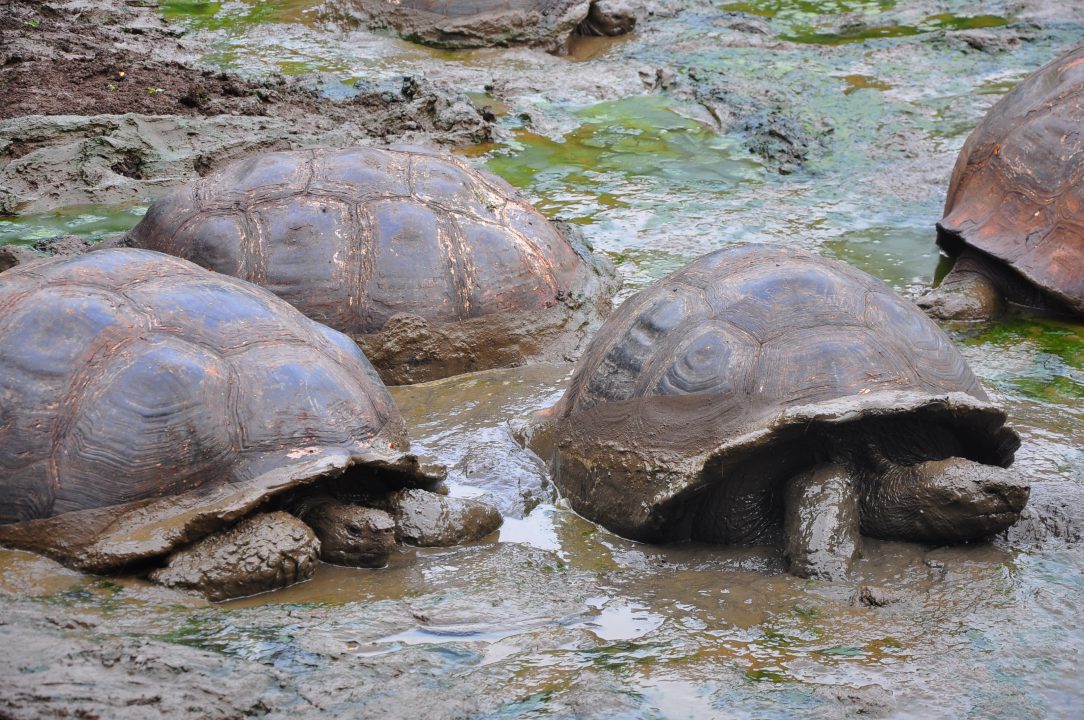
We also walked through a lava tube, stumbling through the dark.

Back on the boat, we cruised to Bartolome Island, a dazzling, dramatic harbor with a gold sand beach. During the snorkel, Julian and I were surrounded by penguins, alternately swimming after them and watching them dodge around us, along with sea lions. We swam through crevices in the lava rock filled with schools of fish. Cleo and Sarah saw a white-tipped reef shark. The kids are both exhibiting a new level of confidence in the ocean. Both of them also have great eyes and are very helpful in spotting hard-to-find animals.
There are much fewer passengers on board now than for the first tour, and everything seems a little calmer.
Later in the afternoon, we climbed to the top of Bartolome via a long staircase, crossing Martian terrain. A Galapagos snake slithered past us and, far below, dolphins splashed in the surf (unlike L.A. and Hawaii, dolphins are a rarity here). From the summit, we could see several islands and track the process of their formation, as well as the infamous Pinnacle Rock.

After the hike, we toured the cliffs in our dinghy and spotted more penguins.
7/4 – Such a relief to be here, cut off from the rest of the world, on Independence Day, and to be spared the chest-thumping patriotism and explosions in the age of America First.
In the morning, we arrived at South Plaza Island, memorable for its cacti (strange and tree-like), red ground cover (the vesuvium plant), and the hatchery of the solitary gull (the bird with the bright red eye ring).
It continues to be a revelation how different the islands are from one another, given that they’re so close to each other and basically all volcanic, desert islands.
I wanted to call this blog “The Origin of the Origins” – which would fit nicely with “Starting From Zero” and the general theme of starting fresh – but then, while reading The Origins of the Species in preparation for this trip, I noticed that the Galapagos plays a very small role (though some would argue a crucial one) in the book. The interesting thing is that once you get here, you can’t imagine a better laboratory in which to study evolution.
The landing at South Plaza was in the middle of lots of solitary gull chicks and eggs, and you had to pay special attention to where you stepped. We saw Nazca boobies and storm petrels.
Later, as we were circling back to the landing, we looked out into the ocean and saw a massive feeding frenzy of mullets (large green fish), churning the surface of the ocean along with king angel fish, an unusual occasion when binoculars were as good as a mask and snorkel.
Our new guide Billy is more eloquent and well-spoken than Gustavo. He’s also very good at incorporating scientific theory into specific examples of what we’re seeing. Still, Gustavo was great at forming a bond with the kids, and especially with Julian, and we miss him.
This morning Billy talked about why we can’t intervene in nature, that everything was in a delicate balance and that intervening would throw things out of whack. For example, if you decided to save starving seal pups that had been orphaned, you would be endangering seal pups yet to be born, that that all of them would be competing for the same food supply. “This is Darwin’s selection in action. It’s cruel, but it works.” There was a silence among the group after he said this as we looked at all the islands and wildlife around us, and then at ourselves. Have we been spared this exacting selection, or are we just playing out another form of it?
In the afternoon, our first bad snorkeling experience (water super choppy). It seems that the warmer the water gets, the less visibility we’re finding.
North Seymour Island in the afternoon. An islet of strange, Seussian plants that look like cactus growing out of a telephone pole.
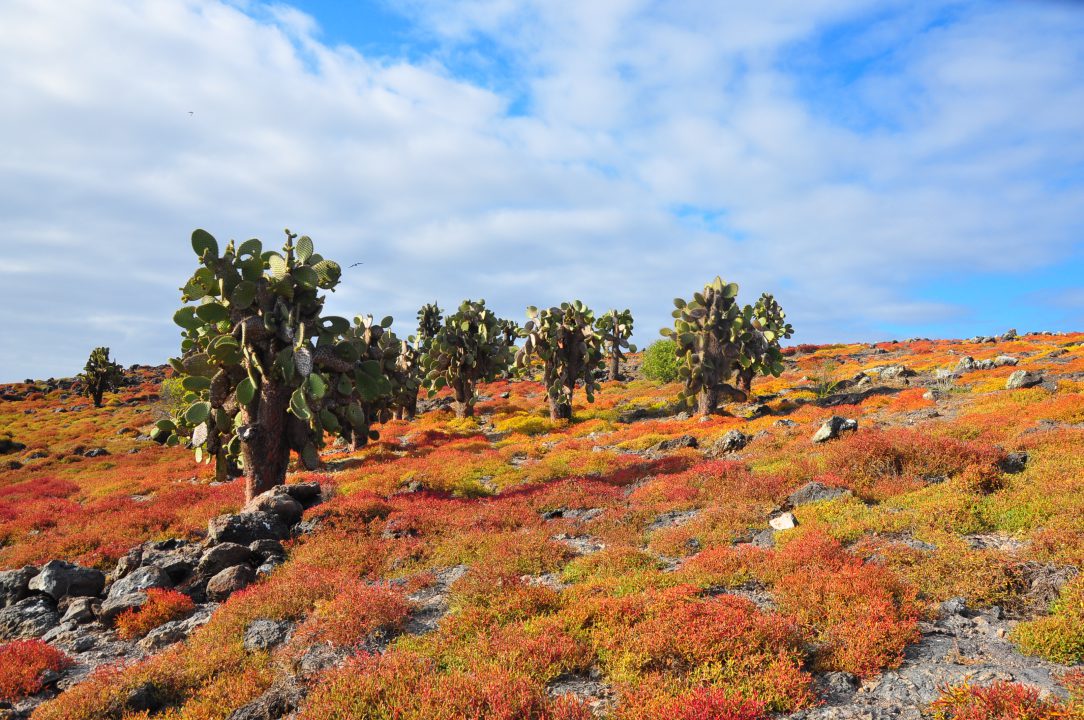
Incredible frigatebird breeding ground. Frigatebirds don’t adhere to a rigid mating schedule so we got to see them at all stages of reproduction. Courtship was the most photogenic stage: The males’ chests were inflated into red balloons, which dotted the sandy island like lost party favors.

The chicks are comical. They’re often as large as the adult but covered in white fuzz, and their wings look strangely emaciated without feathers. On one chick we saw the little shoots of feathers coming in.
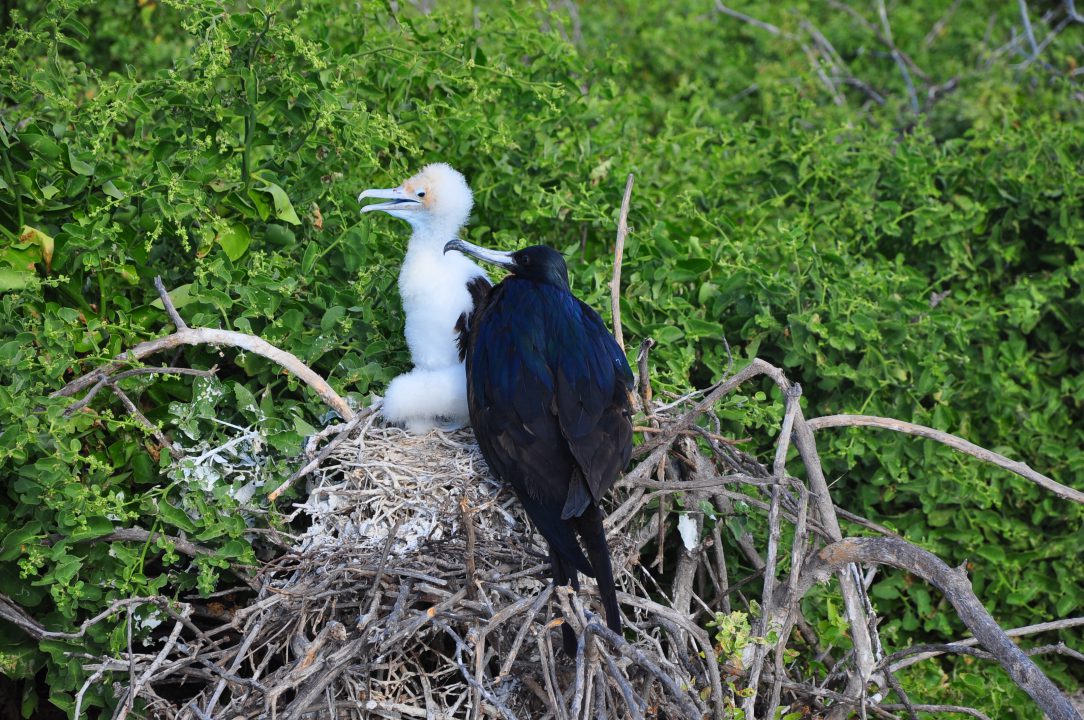
We also saw many blue-footed boobies nesting. They nest on the ground in the middle of a ring of bird poo; the guano shoots out of this ring like spin-art, forming a kind of aurora. Its highly acidic due to the birds’ high salt intake. The poo ring wards off enemies and keeps their young close to home. (Details like this keep Julian on these tours. Thank God for the sheer earthiness of Earth.)
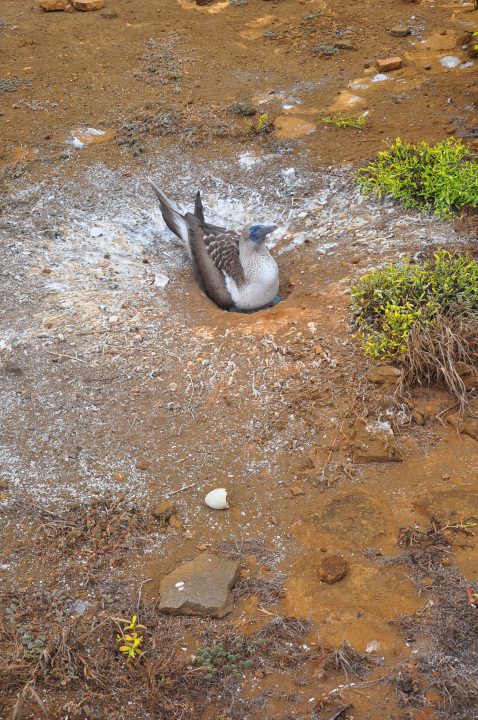
Speaking of which: Our guide Billy said something profound on the tour about life and death, after which one of our fellow tourists farted loudly. Cleo and I got the church giggles and couldn’t stop laughing for the rest of the tour.
Another meditation by Billy: He talked about how specific nature is with the use of color. Danger is always associated with the colors yellow and black. It appears in dangerous animals: Bees, wasps, tigers, venomous snakes. And how we as humans have adopted the same colors for street signs warning of danger: FALLING ROCK, TRAIN CROSSING, YIELD.
7/5 – The tour is winding down and it’s sad – we’ll probably never be this well taken care of again on our six-month trip. The last three days really went by in a wash; it doesn’t seem long ago that we thought we’d have all the time in the world. Now we’re down to our last full day. Cleo said that the first cruise felt like four weeks and the second felt like four seconds (while they were both about four days).
Woke up to some violent pitching of the boat and an idea for a sketch that we could put on to mark the end of our time on the boat. Wrote it down before I forgot. When I first brought it up at breakfast to Cleo, she said she didn’t want to do it, but when I told her the idea, she wanted to do it, and from that moment on became the driving force behind the production. Cleo’s new friend Amira paid me the ultimate compliment: “That’s the best thing I ever heard.”
I’ll try to get it scheduled during the end-of-tour festivities tonight.
This morning: Punta Pitt on Cristobal Island, a dramatic mountain on the edge of the sea. We climbed up through an open lava tube to a plateau dotted with blue-footed booby nests, the boobies each sitting in the middle of their sunbursts of poo. On the other side of the island, we came into contact with our first red-footed boobies – unlike their relatives, they nest in trees.
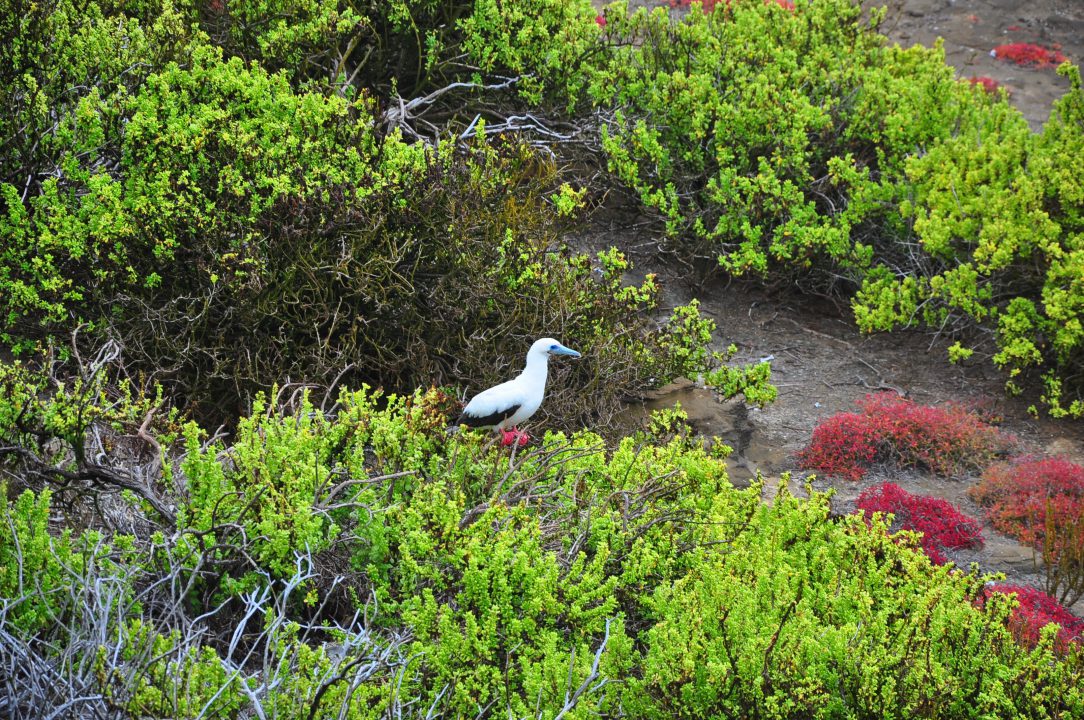
(This is the only spot in the Galapagos that has all three types of boobies – of course we had to come here.) They live up to the hype: Their feet are a beautiful deep red and their beaks a combination of pink and blue.
I cannot say enough about the colors on this island. The beach is olive-green (we’re now up to five different beach colors); there was blue lichen lining the rocks on the climb up and red vesuvium on top.
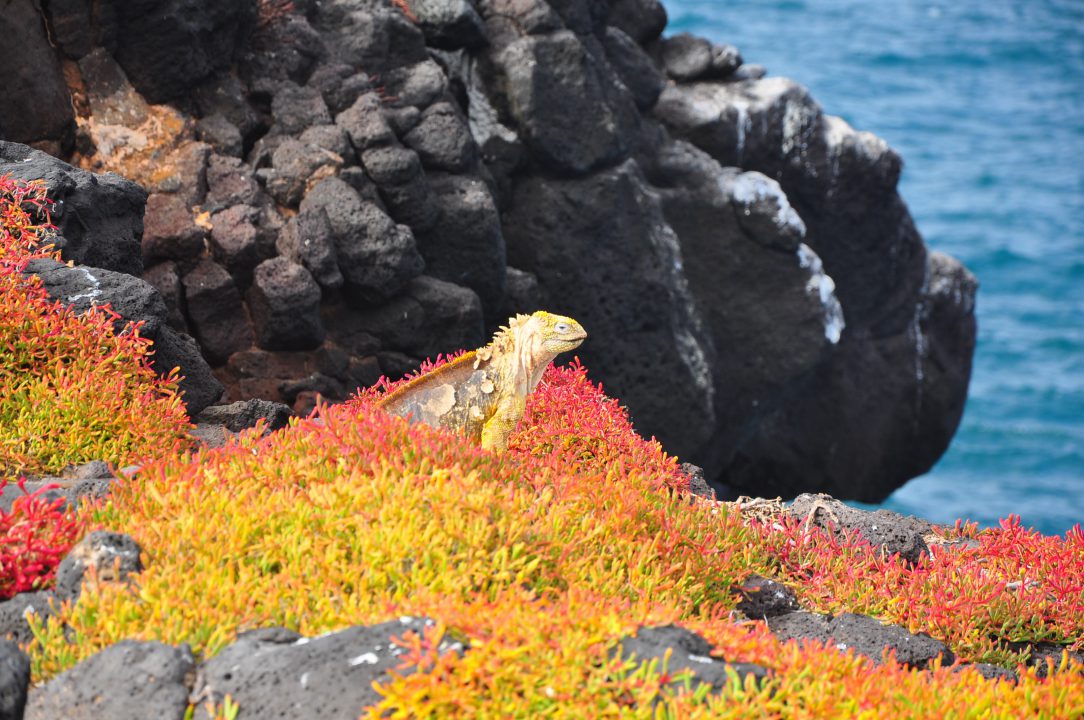
Snorkeling afterwards was great; the sea lions cavorted all around us, rolling, diving. Julian and I saw a big purple conch shell on the sea floor and dove down to it. The creature inside was even more purple. Again, the colorful nature of these ostensibly drab desert islands continues to confound.
After lunch, Cerro Brujo (Wizard’s Hill). This was mostly a beach hang-out, very relaxed, no tour. The beach was spectacular, like something on an untouched island in the Caribbean – powder white sand and translucent turquoise waters.


Julian seemed to explode at being unguided on an island and played in the waves like a seal pup, joined eventually by Cleo and Amira.
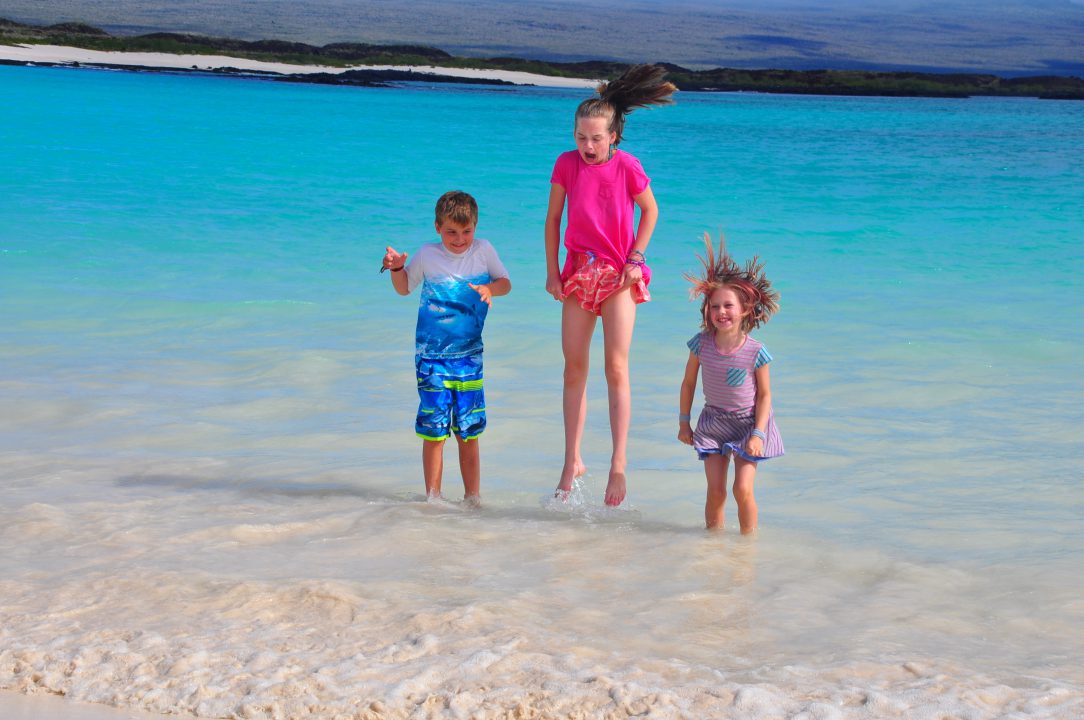
Sarah, Taylor (father of Amira, from the Tucson family) and I attempted to snorkel around a point, which was harder than it looked with currents running against us and poor visibility. We did see an eel, though, so it was all worthwhile.
Back to the boat for an ice cream social on the moon deck (the top deck of the boat). We were all talking about how amazing this was, eating ice cream while looking out on Kicker Rock (one of the more photogenic rocks in the archipelago), how it couldn’t get any better when we spotted several dolphins leaping from the sea, glistening grey in the sunset. Too much beauty.
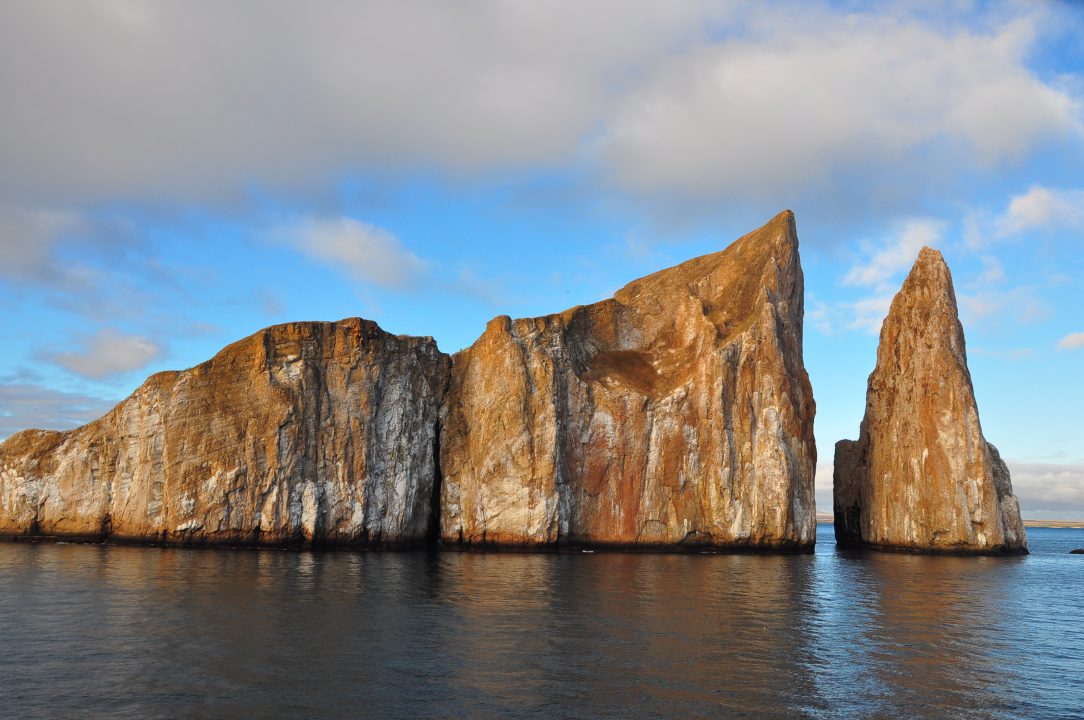
After ice cream, we put on our sketch or “representacion,” as the crew member who introduced us called it. (There doesn’t seem to be a Spanish word for comedy sketch. When I told various crew members about our plans, none of them seemed to understand what I was proposing. But the thing is, they’re basically trained to say yes [or si], so they couldn’t say no to me. They’re lucky I wasn’t some crazy preacher or a salesman for Herbalife. Even though they didn’t understand what I wanted to do, the one thing they wanted to know was how long. They seemed relieved to hear four minutes.)
NARRATOR: We take you now to a tour in progress on one of the many beautiful islands here in the Galapagos…
GUIDE leads TOURISTS onto stage.
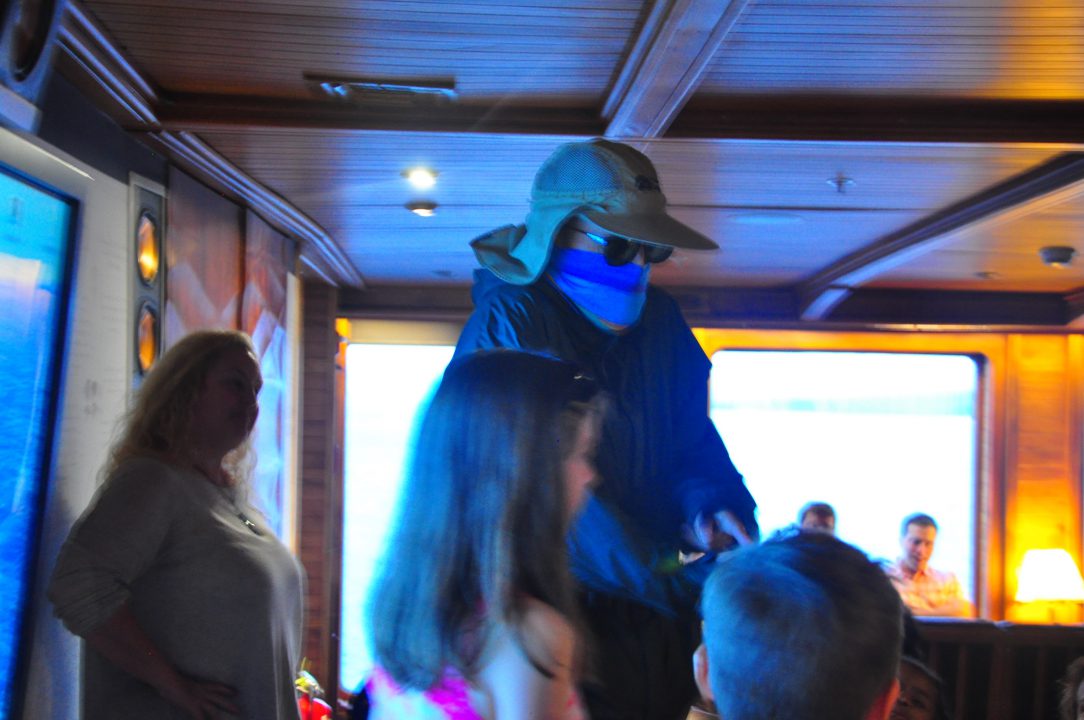
GUIDE is completely covered from head to toe, with dark glasses on top of a face scarf. (This is the way our guide Billy dressed, like the Invisible Man.)

GUIDE: Hokay. On the left we haf boobies. On the right, boobies. Up there, boobies. Down there, boobies. Vamos.
CLEO: Wait. What’s that over there?
GUIDE: Let me see. (He looks through binoculars.) Ah….boobies.
JULIAN: Hey, what’s this in my shirt?
(Julian’s hands, covered with socks, come up from under his shirt – low-tech bird puppets.)
GUIDE: Let me see. (He looks at them through binoculars.) You know what these are? Boobies.
JULIAN: But I don’t want boobies in my shirt.
GUIDE: You know what? The boobies made a choice to nest in your shirt. Nature is smart. There are many tourists on this island. Boobies made an adaptation. You should be happy. Now we need to get back to the boat. Vamos.
AMIRA: But what about Dora? (This is the member of our group who was always getting lost and/or late coming back to the boat.)
GUIDE: Yes, we could save Dora. And I would feel good about myself. But what about the environment? Dora will go on to create more tourists who are late, and the environment cannot support this.
CLEO: But she might die!
GUIDE: Yes. The four potential causes of death in the wild are: 1) Accident. 2) Starvation. 3) Old age. 4) Predators. (This is a standard Billy riff.) Now come, everyone, we must get back to the boat. The schedule is very tight. Twelve noon ice cream social followed by lunch, followed by dessert, followed by dancing competition, followed by lecture on plankton, followed by visit to Booby Island: Dry landing, wet water, hike difficulty high, fitness level required high, mental level required you should get high, so you see, we cannot possibly wait for Dora!
(They all leave.)
(Dora runs up.)
DORA: Wait!
NARRATOR: A million years later, a new species evolved on Galapagos.
KIDS: (dramatic sting) Bum bum bum….
GUIDE leads tourists onstage (minus the kids, who play Doraguanas).
GUIDE: Hokay. One the left we have Doraguanas. On the right we have Doraguanas…
(Doraguanas crawl around the stage, saying: “Take my picture with you!” and “Speak English!”)
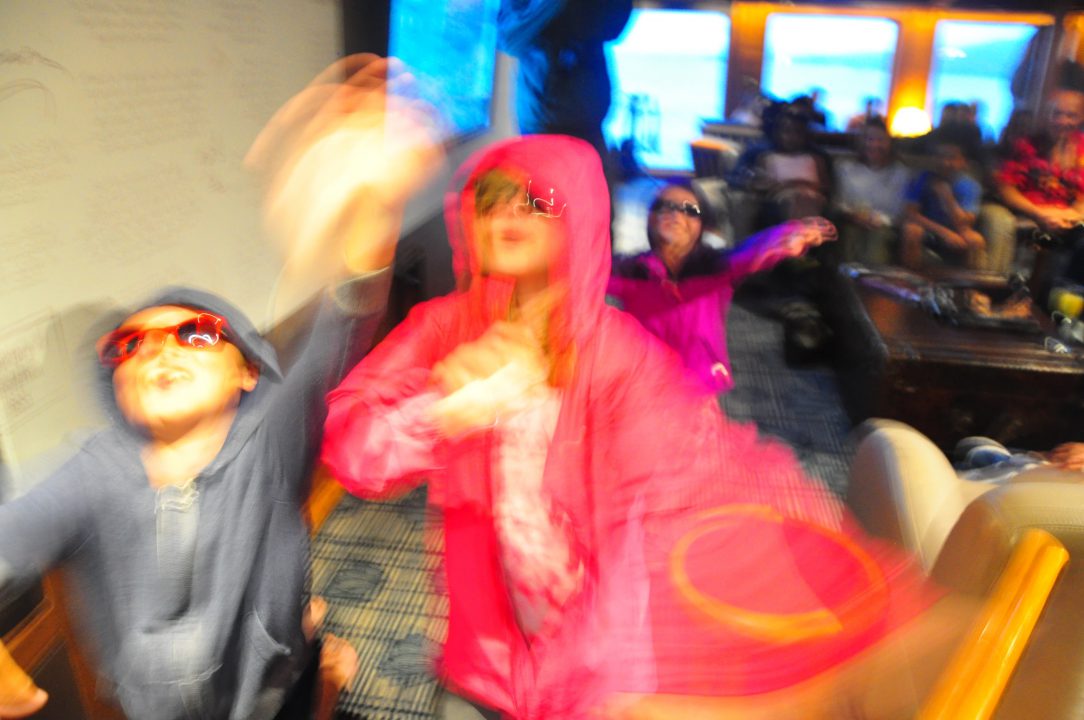
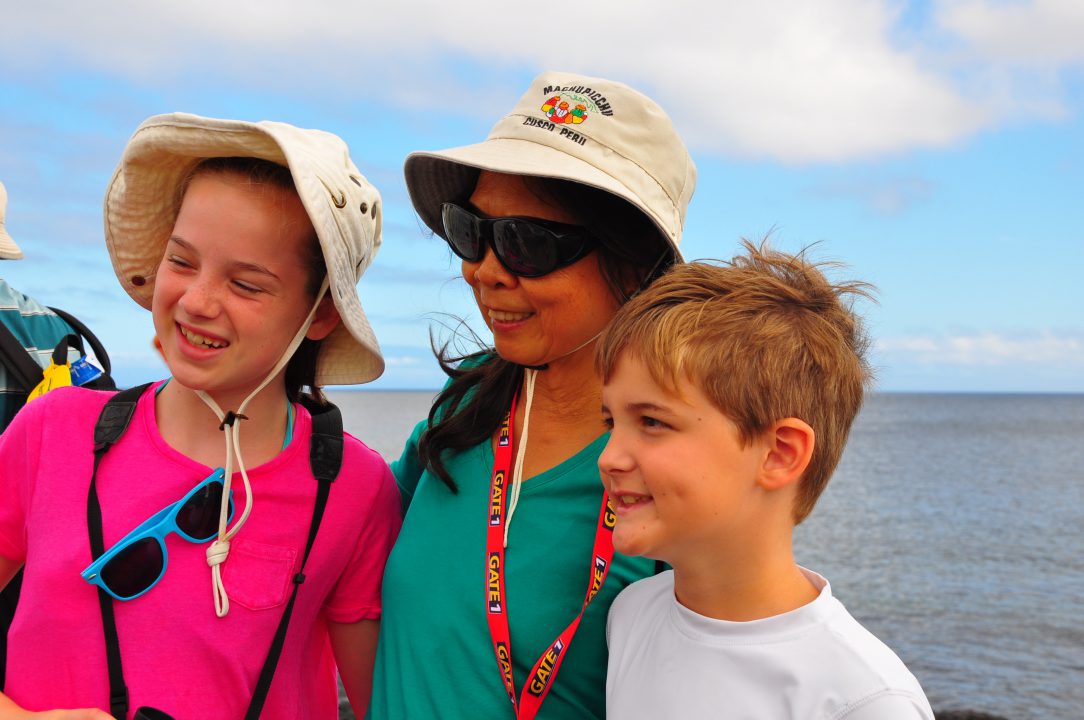
EVERYONE: The end. Muchas gracias to Billy and the entire crew of the Legend and of course to Dora. We love you.
It seemed to go over well; the first half had some good hard laughs. I botched some of my lines as the Guide (I think I was a little intimidated by having Billy standing right there). The kids were great and so was Zakaia, our new friend from the UAE who took over the narrator’s role and ran with it. Billy fortunately loved the sketch and gave us big hugs afterwards.
7/6 – Visit to a turtle hatchery to see baby tortoises, lunch (lobster ceviche and fish in a curry salsa) in Puerto Moreno, then a flight back to Quito.
There’s almost too much to process about this visit right now but the lingering impression is the importance of diversity in our world. Every species we saw contributed something important to the special ecosystem of the Galapagos and made me realize how interlocked we all are. Not to get too preachy, but you begin to realize that it’s a very thin line between an ocean full of life and the surface of Mars; the species themselves can adapt to a point, but once they begin to collapse, it’s like a row of dominos with humans standing at the end.
I don’t think it’s a coincidence that in the political world of humans, intolerance for human diversity (ie, immigration) is often accompanied by intolerance for environmental safeguards. The way these humans see it, we’re better off as a monolithic culture that doesn’t need/can’t possibly adapt to change, doesn’t need other kinds of people or other kinds of animals. This kind of thinking is our doom. If these fragile, miraculous islands show us anything, it’s that we need different kinds of life to make a full life.



